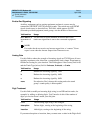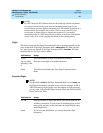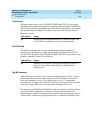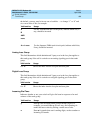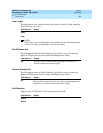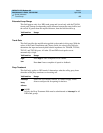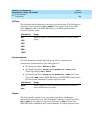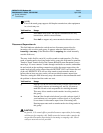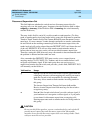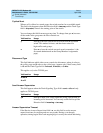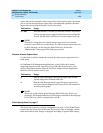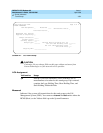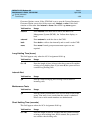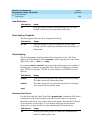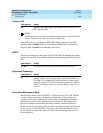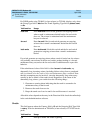
DEFINITY ECS Release 8.2
Administrator’s Guide
555-233-506
Issue 1
April 2000
Screen reference
998Trunk Group
17
Disconnect Supervision-Out
This field indicates whether the switch receives disconnect supervision for
outgoing calls over this trunk group. It appears when the Direction field is either
outgoing or two-way. (If the Direction field is incoming, the switch internally
sets this field to
n.)
The entry in this field is crucial if you allow trunk-to-trunk transfers. (To allow
trunk-to-trunk transfers involving trunks in this group, this field must be
y and the
Trunk-to-Trunk Transfer field on the Feature-Related System Parameters screen
must be
y). If a user connects 2 trunks through conference or transfer, and neither
far-end switch on the resulting connection provides disconnect supervision, the
trunks involved will not be released because DEFINITY ECS can’t detect the end
of the call. DEFINITY ECS will not allow trunk-to-trunk transfers unless it
believes that at least one party on the call can provide disconnect supervision.
Therefore, setting this field incorrectly may cause trunks to become unusable until
the problem is detected and the trunks are reset.
Also, remember that DEFINITY ECS must receive answer supervision on
outgoing analog CO, FX, WATS, Tie, Tandem, and Access trunks before it will
recognize a disconnect signal. If this trunk group does not receive answer
supervision from the far-end switch, and you enter y in this field, DEFINITY ECS
will internally set the field to n.
!
CAUTION:
Do not set this field to
y
unless you are certain that the far-end switch will
provide answer supervision and disconnect supervision. Most public
networks do not provide disconnect supervision over analog trunks. Check
with your network services provider.
Valid entries Usage
y
Enter y if (a) the far-end switch sends a release signal when the
called party releases a call an outgoing call, and (b) you want to
make the far-end switch responsible for releasing the trunk.
This entry allows trunk-to-trunk transfers involving trunks in
this group.
The Answer Supervision Timeout field must be
0 and the
Receive Answer Supervision field must be
y for the switch to
recognize a
y entry.
n Enter n if the far-end switch doesn’t provide a release signal, if
your hardware can’t recognize a release signal, or if you prefer
to use timers for disconnect supervision on outgoing calls.
Entering
n prevents trunk-to-trunk transfers involving trunks in
this group.



